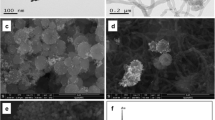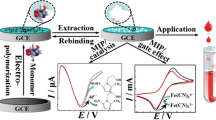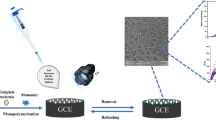Abstract
Tiotropium bromide (TIO) is a long-acting bronchodilator used in the treatment of chronic obstructive pulmonary disease (COPD) and asthma. Specifically, it is used to prevent patients from worsening breathing difficulties. In this study, a new TIO-imprinted electrochemical sensor was designed to detect TIO in serum and pharmaceutical samples. Methacryloyl-L-histidine-cobalt(II) [MAH-Co(II)] has been used as a metal-chelating monomer for synthesizing selective molecularly imprinted polymer (MIP). MIP film has been developed on glassy carbon electrodes using MAH-Co(II) as the functional monomer, 2-hydroxyethyl methacrylate (HEMA) as the basic monomer, and ethylene glycol dimethacrylate (EGDMA) as the cross-linker in the photopolymerization method. The surface characterization of the developed MAH-Co(II)@MIP/GCE electrochemical sensor was done using scanning electron microscopy (SEM) and Fourier transform infrared spectroscopy (FTIR). Also, the electrochemical behavior of the sensor was provided by differential pulse voltammetry (DPV), cyclic voltammetry (CV), and electrochemical impedance spectroscopy (EIS) techniques. Under optimized experimental conditions, the linearity range was in the range of 10–100 fM, and the limit of detection (LOD) and limit of quantitation (LOQ) values were calculated as 2.73 fM and 9.75 fM, respectively. The MAH-Co(II)@MIP/GCE sensor was used to precisely determine TIO in capsule and commercial serum samples. The results demonstrated that the MIP could specifically recognize TIO compared to structurally related drugs and could be reliably applied to the direct determination of drugs from real samples.
Graphical abstract






Similar content being viewed by others
References
Yehia AM, Abo-Elhoda SE, Hassan NY, Badawey AM. Experimental validation of a computationally-designed tiotropium membrane sensor. New J Chem. 2018;42:16354–61. https://doi.org/10.1039/C8NJ03507E.
Chi J, Li F, Jenkins R. Ultrasensitive sub-pg/ml determination of tiotropium bromide in human plasma by 2D-UHPLC-MS/MS: challenges and solutions. Bioanalysis. 2016;8:385–95. https://doi.org/10.4155/bio.15.256.
Zayed S, Fouad F, Belal F. A simple and economic chromatographic method for simultaneous determination of six bronchodilator drugs in pharmaceutical dosage forms. J Iran Chem Soc. 2021;18:1251–9. https://doi.org/10.1007/s13738-020-02107-6.
Elkady EF, Tammam MH, Elmaaty AA. Development and validation of RP-HPLC method for simultaneous estimation of tiotropium bromide, formoterol fumarate, and olodaterol HCl in bulk and metered dose aerosols: application to olodaterol HCl forced degradation study and degradation kinetics. Chromatographia. 2017;80:1749–60. https://doi.org/10.1007/s10337-017-3413-0.
Joung SK, Kang SY, Ma KN, Kim SA, Cho K, La S, Lee HJ. Bioanalytical validation for the determination of fluticasone propionate, salmeterol and tiotropium in human plasma at the sub pg/mL level using UPLC/MS/MS. Drug Metab Pharmacokinet. 2017;32:S27. https://doi.org/10.1016/j.dmpk.2016.10.128.
Ding L, Tan W, Zhang Y, Shen J, Zhang Z. Sensitive HPLC-ESI-MS method for the determination of tiotropium in human plasma. J Chromatogr Sci. 2008;46:445–9. https://doi.org/10.1093/chromsci/46.5.445.
Wang J, Jiang Y, Wang Y, Li H, Fawcett JP, Gu J. Highly sensitive assay for tiotropium, a quaternary ammonium, in human plasma by high-performance liquid chromatography/tandem mass spectrometry. Rapid Commun Mass Spectrom. 2007;21:1755–8. https://doi.org/10.1002/rcm.
Sarvestani MRJ, Madrakian T, Afkhami A. Developed electrochemical sensors for the determination of beta-blockers: a comprehensive review. J Electroanal Chem. 2021;899:115666. https://doi.org/10.1016/j.jelechem.2021.115666.
Çorman ME, Cetinkaya A, Ozcelikay G, Özgür E, Atici EB, Uzun L, Ozkan SA. A porous molecularly imprinted nanofilm for selective and sensitive sensing of an anticancer drug ruxolitinib. Anal Chim Acta. 2021; 1187.https://doi.org/10.1016/j.aca.2021.339143.
Kaya SI, Cetinkaya A, Ozcelikay G, Çorman ME, Karakaya M, BellurAtici E, Ozkan SA. Computational design and fabrication of a highly selective and sensitive molecularly imprinted electrochemical sensor for the detection of enzalutamide. J Electroanal Chem. 2022;907:116030. https://doi.org/10.1016/j.jelechem.2022.116030.
Cetinkaya A, Kaya SI, Çorman ME, Karakaya M, BellurAtici E, Ozkan SA. A highly sensitive and selective electrochemical sensor based on computer-aided design of molecularly imprinted polymer for the determination of leflunomide. Microchem J. 2022;179:107496. https://doi.org/10.1016/j.microc.2022.107496.
Armutcu C, Özgür E, Çorman ME, Uzun L. Interface imprinted polymers with well-oriented recognition sites for selective purification of hemoglobin. Colloids Surfaces B Biointerfaces. 2021; 197.https://doi.org/10.1016/j.colsurfb.2020.111435.
Armutcu C, Tartan Ç, Özgür E, Nemutlu E, Uzun L. Phosphate anion ımprinted cryogel cartridges for selective preconcentration of phosphorylated amino acids from protein lysate: an alternative sorbent for proteome analyses. ChemistrySelect. 2020;5:11730–6. https://doi.org/10.1002/slct.202001959.
Cetinkaya A, Kaya SI, Ozcelikay G, Atici EB, Ozkan SA. A molecularly imprinted electrochemical sensor based on highly selective and an ultra-trace assay of anti-cancer drug axitinib in its dosage form and biological samples. Talanta. 2021;233:122569. https://doi.org/10.1016/j.talanta.2021.122569.
Cetinkaya A, Yıldız E, Kaya SI, Çorman ME, Uzun L, Ozkan SA. A green synthesis route to develop molecularly imprinted electrochemical sensor for selective detection of vancomycin from aqueous and serum samples. Green Anal Chem. 2022;2:100017. https://doi.org/10.1016/j.greeac.2022.100017.
Odabaşi M, Say R, Denizli A. Molecular imprinted particles for lysozyme purification. Mater Sci Eng C. 2007;27:90–9. https://doi.org/10.1016/j.msec.2006.03.002.
Hur D, Ekti SF, Say R. N-acylbenzotriazole mediated synthesis of some methacrylamido amino acids. Lett Org Chem. 2007;4:585–7. https://doi.org/10.2174/157017807782795556.
Ozkan SA, Kauffmann J-M, Zuman P. Electroanalysis in biomedical and pharmaceutical sciences. In: Scholz F (ed). Springer; 2015. https://doi.org/10.1007/978-3-662-47138-8.
Srinivasu K, Venkateswara Rao J, Appala Raju N, Mukkanti K. Simultaneous RP-HPLC method for the estimation of formoterol fumarate and tiotropium bromide in pharmaceutical dosage forms. Asian J Chem. 2010;22:3943–8.
Bhoomaiah B, Jayasree A. Simultaneous quantification of olodaterol and tiotropium bromide by high-performance liquid chromatography. Asian J Chem. 2017;29:145–8. https://doi.org/10.14233/ajchem.2017.20164.
Funding
Ahmet Cetinkaya received financial support from the Council of Higher Education 100/2000 (YOK) under the special 100/2000 scholarship program and the Scientific and Technological Research Council of Turkey (TUBITAK) under the BIDEB/2211-A Ph.D. and ARDEB/1004 Ph.D. Scholarship Programmes.
Author information
Authors and Affiliations
Corresponding author
Ethics declarations
Ethics approval
No human or animal subjects were used in this study.
Conflict of interest
The authors declare no competing interests.
Additional information
Publisher’s note
Springer Nature remains neutral with regard to jurisdictional claims in published maps and institutional affiliations.
Rights and permissions
Springer Nature or its licensor holds exclusive rights to this article under a publishing agreement with the author(s) or other rightsholder(s); author self-archiving of the accepted manuscript version of this article is solely governed by the terms of such publishing agreement and applicable law.
About this article
Cite this article
Cetinkaya, A., Kaya, S.I., Atici, E.B. et al. A semi-covalent molecularly imprinted electrochemical sensor for rapid and selective detection of tiotropium bromide. Anal Bioanal Chem 414, 8023–8033 (2022). https://doi.org/10.1007/s00216-022-04335-6
Received:
Revised:
Accepted:
Published:
Issue Date:
DOI: https://doi.org/10.1007/s00216-022-04335-6




